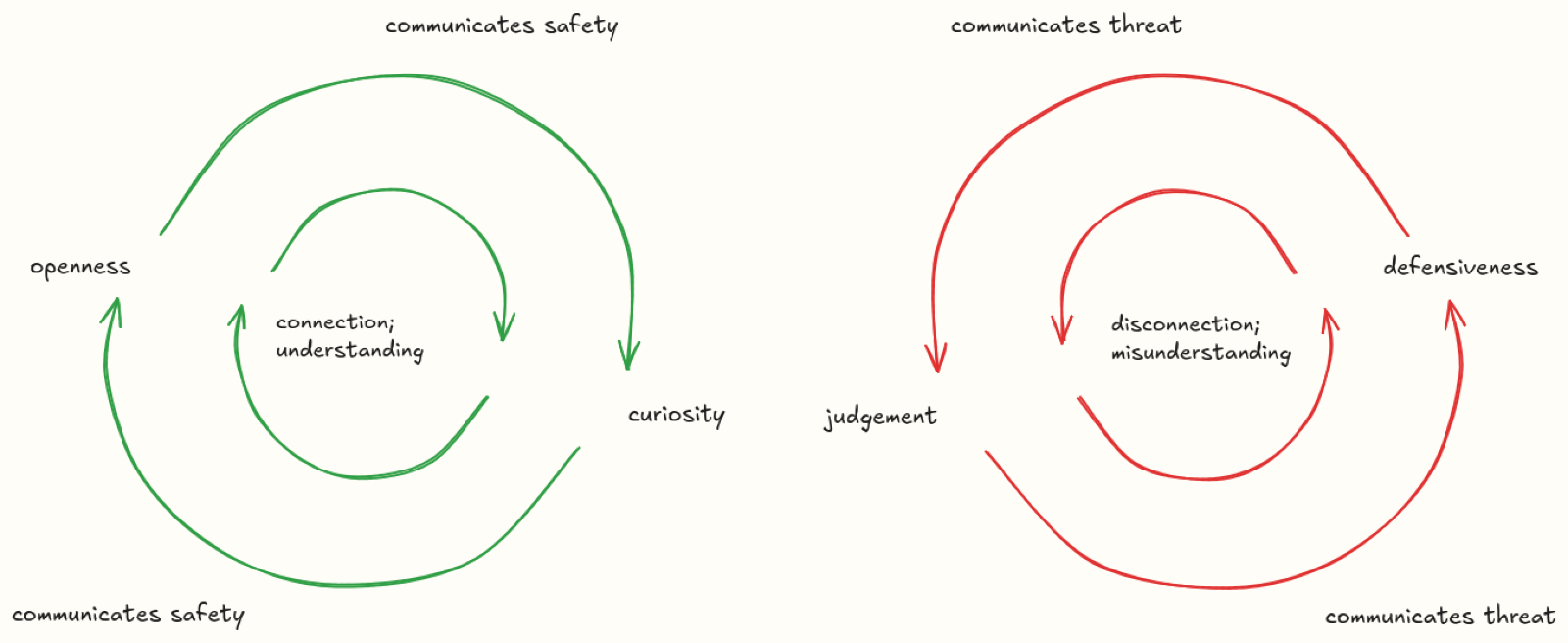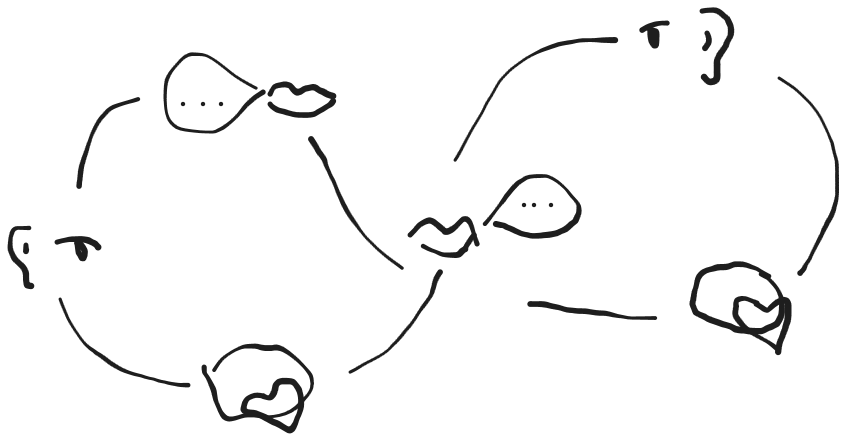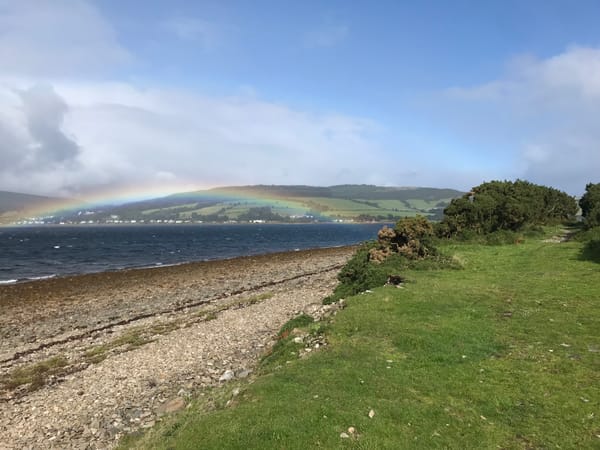convergence: listening (part 2)

post 5 of #100DaystoOffload
Last post I introduced three points in a constellation about listening. Some excerpts from Friedman and Packer about nondefensive listening; Rogers and Farson about active listening; and Manske about the relationship between safety, curiosity, openness and learning. Now coming back to these, it's time to synthesise.
Packer's contribution recognises the difficulty—but necessity—of working to listen to one another without feeling threatened, defensive or insecure (ambition, envy, judgement of others). This is about openness, or lack of openness, in the listener.
While Rogers and Farson are talking about active listening as a way to cultivate openness in the person being listened to. They say active listening reduces the sense of threat in a speaker—threat to their ideas or identity. Thus the speaker can be less defensive; more articulate; more open to to analytical thinking and to change; more able to hold things lightly.
Bringing these together suggests: there is a feedback loop, a mutual emotional regulation happening in dialogue where one or both parties feel safe and can signal this. And, it follows that things can spiral in a negative direction too. We can escalate perceived threats and defensiveness.

An optimistic gleaning here is that an interaction can be transformed by either person.* An interaction is a dynamic unfolding, co-constituting, where we are constantly reacting to one another and modulating our thoughts, feelings, expressions. Our own state matters for regulating another person. If someone is getting frustrated or angry or indeed defensive: that is a cue for us to pause and examine not only how we are reacting, but how we are showing up as a listener that is shaping the environment of the exchange. In nonviolent communication (NVC) terms we might talk about the quality of attention that you are able to give.

The broader context of Rogers and Farson's Active Listening booklet makes it clear that the role of "active listener" includes speaking, in terms of reflecting back and engaging empathetically with what someone has said. So they are describing a whole interaction, not simply a desirable way of listening when someone else talks. Whereas what Friedman highlights of Packer's teaching seems applicable to the act of listening moment-to-moment, rather than the whole choreography of turn-taking as speaker and listener. Packer seems more focussed on the inner work of attention, awareness, vigilance against our "tendencies" to judgement and defensiveness. I see these as complementary orientations: inward (Packer) and outward (Rogers and Farson); micro moment and whole process.


The cycle of hearing and listening. tuning in to self and other... A bit like a Klein bottle? (Sketch my own, where the bottom squiggles are a poor scrawl of brain(head) and heart! And Klein bottle image by Tttrung via Wikipedia, CC BY-SA 3.0)
Now, as Friedman and Packer realise, nondefensive listening is not easy and takes "tremendous attention, and energy of awareness". This is daunting. Similarly, Rogers and Farson acknowledge the challenge (bold=my emphasis):
If, however, we can free ourselves from the need to influence and direct others[...]
Rogers and Farson (2015 [1957]), p.7
To be effective at all in active listening, one must have a sincere interest in the speaker [...] And if we are only making a pretense of interest in the speaker, [they] will quickly pick this up, consciously or unconsciously.
Ibid., p.15
And perhaps most starkly:
Active listening carries a strong element of personal risk. If we manage to accomplish what we are describing here—to sense deeply the feelings of another person, to understand the meaning his [sic] experiences have for him, to see the world as he sees it—we risk being changed ourselves. [...] It is threatening to give up, even momentarily, what we believe and start thinking in someone else's terms. It takes a great deal of inner security and courage to risk one's self in understanding another.
Ibid.
...I will be the first to admit that in these terms, I am at the start of my journey as a deep listener. Just beginning to develop awareness and skill.
So then I return to Jim Manske and the "Pathways to Liberation: Matrix of Self-Assessment".
Packer, Rogers and Farson introduce the negative impact of defensiveness on listener and speaker alike. One of our tasks, if we wish to improve as listeners, is to develop skills that will enable us to notice and disable or disarm our defensiveness. Following the logic above, we can then expect to lower the incidence of others' defensiveness. Wonderful.
As I quoted Manske last time, he states that we need to feel sufficiently secure and rooted, to have the requisite curiosity and openness to learn/develop skills. In other words, to change. Rogers and Farson make clear that active listening is a process of (openness to) change. So, Manske's conditions are exactly relevant here. Metaphorically it's about finding the sweet spot of the "Learning Zone", between the "Comfort Zone" and the "Panic Zone".**
In addition, the skills Manske presents in the Matrix are awareness skills, the very scaffolding for nondefensive, active listening. A couple of examples:
Presence. "Being attentive to what is happening right now. Not lost in thinking, emotional reaction, etc." Someone becoming aware of this skill is "Becoming aware of the difference between what is actually happening and being lost in thought". (Manske [date], p.25)
Self-empathy, or "recovering from reactivity". "Reconnecting to self is being with one's own experience with presence and compassion". If you are unaware of the skill, you are likely "mostly unconscious of habitual reactive patterns". (p.31)
Responding to others' reactivity. "Responding rather than reacting to others who are caught up" in intense emotions. Unconsciously incompetent (unskilled): "Reacts habitually with defensiveness, submissiveness or avoidance when others are triggered". Awakening and developing skill: "increasingly notices one's own habitual reactions and their effect on connection". (p.41)
I hope that you can also see that these skills could be precisely supportive of the active, nondefensive listening envisioned by Packer and Rogers and Farson.
Or, at least, if we find this bundle of theory stands up to more critical scrutiny! And how would we go about researching the effectiveness of any of thsi anyway?
We will have to wait and see in part 3...
In the meantime, if you're reading this, any thoughts and feedback would be welcomed.

*Thinking in terms of dyads (pairs) for fundamental simplicity. Though of course this could be expanded to larger groups, with a corresponding complexity increase.
**This is something that came to mind as a received idea, but I had to look up the attribution. A quick search yields lots of people claiming it's by someone called Tom Senninger, who in turn based it on/adapted education psychologist Lev Vygotsky's "zone of proximal development" (which is a different thing, but also represented in terms of zones and concentric circles!). BUT this has raised two thorny issues which are beyond scope here: a) is this a mythical attribution? can I find the original Senninger work? I'd need to hunt around; b) is the "comfort zone"—or even Manske's model of human curiosity and security for learning—a model or a metaphor?
References
Toni Packer (1990) The Work of This Moment. Access free here (with an account): https://archive.org/details/workofthismoment00pack/mode/2up
Carl Rogers and Richard Farson (2015 [1957]) Active Listening. (A short version is available free online in PDF form but I bought a little booklet reprint of the full text on eBay I think.)
Jim Manske (2021) Pathways to Nonviolent Communication: A Tool for Navigating Your Joruney. https://nonviolentcommunication.com/product/pathways-to-nvc/
Also see the online free version of the Matrix at https://pathwaystoliberation.com/the-matrix/




